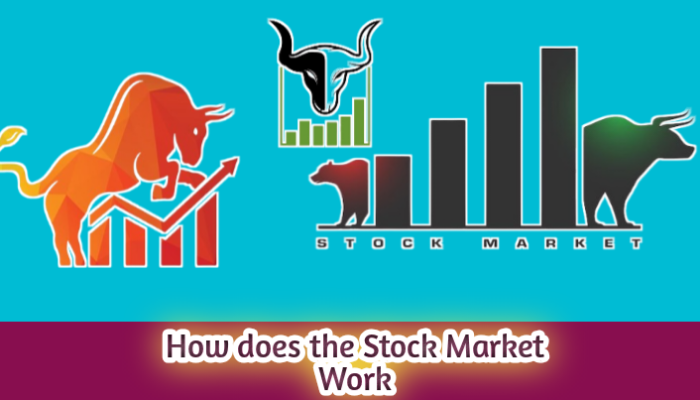How does the Stock Market work The stock market is often seen as a mysterious place where fortunes are made and lost. For beginners, terms like shares, stocks, IPOs, dividends, and trading can feel overwhelming. Yet, the stock market plays a crucial role in the economy, helping businesses grow and giving individuals opportunities to build wealth.
If you’ve ever wondered, “How does the stock market actually work?”, this detailed guide will simplify the concept. By the end, you’ll understand the basics of stock trading, why the market exists, how prices move, and how you can participate safely.
1. What is the Stock Market?
The stock market is a global marketplace where people buy and sell shares of companies. A share (or stock) represents a small piece of ownership in a company. When you buy shares of a company, you become a part-owner of that business.
For example, if a company has 1,000 shares and you own 10, you own 1% of that company. This ownership gives you potential benefits such as dividends (profit-sharing) and capital gains (profits from rising share prices).
2. Why Does the Stock Market Exist?
The stock market benefits both companies and investors:
- For Companies
- They raise money by selling shares through an IPO (Initial Public Offering).
- The raised funds can be used for expansion, research, or paying off debts.
- For Investors
- It provides opportunities to grow money over time.
- It allows portfolio diversification.
- It helps beat inflation by offering higher returns compared to savings accounts.
In short, the stock market is a bridge between businesses needing funds and investors seeking profits.
3. Players in the Stock Market
To understand how the stock market works, you need to know who participates in it:
- Retail Investors – Individuals like you and me who buy and sell stocks.
- Institutional Investors – Large organizations such as mutual funds, hedge funds, pension funds.
- Stockbrokers – Licensed agents who execute trades on behalf of investors.
- Regulators – Bodies like the SEC (Securities and Exchange Commission) in the US, or SEBI (Securities and Exchange Board of India), which ensure fair practices.
- Exchanges – Platforms like NYSE, NASDAQ, BSE, NSE, where shares are traded.
4. How Does the Stock Market Work? Step by Step
1. Companies Issue Shares
- A company decides to raise money through an IPO.
- Investors purchase shares during the IPO.
- After the IPO, shares are listed on the stock exchange.
2. Buying and Selling of Shares
- Once listed, shares are traded daily.
- Investors place buy and sell orders through stockbrokers.
- Prices move based on supply and demand.
3. Price Movements
The price of a stock rises when more people want to buy it than sell it.
- High Demand → Price Goes Up
- High Supply → Price Goes Down
Example: If Apple launches a successful product, demand for its stock rises, pushing the price up.
4. Making Profits
Investors earn profits in two ways:
- Capital Gains – Selling stocks at a higher price than purchased.
- Dividends – A portion of company profits distributed to shareholders.
5. What Determines Stock Prices?
Several factors affect stock prices:
- Company Performance – Earnings, revenue growth, leadership.
- Economic Conditions – Inflation, interest rates, GDP growth.
- Global Events – Wars, pandemics, political instability.
- Investor Sentiment – Fear and greed drive market behavior.
- Market Speculation – Short-term traders and news impact volatility.
6. Types of Stock Markets
- Primary Market – Where companies issue new shares through IPOs.
- Secondary Market – Where existing shares are traded among investors.
7. Types of Stocks
- Common Stocks – Provide voting rights and dividends.
- Preferred Stocks – No voting rights but higher claim on dividends.
- Growth Stocks – Belong to companies expected to grow rapidly.
- Value Stocks – Undervalued stocks with potential long-term growth.
- Blue-Chip Stocks – Stable, well-established companies like Microsoft or Reliance.
8. Stock Market Indices
An index measures the performance of a group of stocks. Popular indices include:
- Dow Jones Industrial Average (DJIA) – 30 major US companies.
- S&P 500 – 500 leading US companies.
- NASDAQ Composite – Tech-heavy index.
- NIFTY 50 (India) – Top 50 companies listed on NSE.
- BSE Sensex (India) – 30 well-established companies listed on BSE.
Indices act like thermometers of the economy, showing whether the market is hot or cold.
9. How Do You Invest in the Stock Market?
- Open a Trading and Demat Account
- Needed to buy and hold stocks.
- Choose a Stockbroker
- Brokers like Zerodha, Robinhood, or Fidelity provide trading platforms.
- Research Before Investing
- Study fundamentals, company reports, and industry trends.
- Start Small
- Begin with small investments to gain confidence.
- Diversify Portfolio
- Spread investments across multiple sectors to reduce risk.
10. Common Stock Market Strategies
- Long-Term Investing – Buy and hold quality stocks for years.
- Day Trading – Buying and selling within the same day.
- Swing Trading – Holding stocks for days or weeks.
- Value Investing – Buying undervalued stocks (popularized by Warren Buffett).
- Growth Investing – Investing in fast-growing companies.
- Dividend Investing – Focusing on companies that pay regular dividends.
11. Risks of Stock Market Investing
- Market Volatility – Prices fluctuate daily.
- Emotional Decisions – Fear and greed often cause losses.
- Economic Downturns – Recessions can reduce stock value.
- Company Risks – Poor management or scandals can crash stocks.
12. Benefits of Stock Market Investing
- Wealth Creation – Higher returns compared to fixed deposits or savings.
- Liquidity – Stocks can be easily bought or sold.
- Ownership – You become part-owner of a business.
- Beating Inflation – Stocks usually provide better returns than inflation rates.
13. Stock Market Myths vs. Reality
- Myth: Stock market is gambling.
- Reality: It’s based on research, fundamentals, and analysis.
- Myth: You need to be rich to invest.
- Reality: Anyone can start with small amounts.
- Myth: Only experts can make money.
- Reality: Even beginners can succeed with the right approach.
14. Future of the Stock Market
The stock market is evolving rapidly with AI-driven trading, digital apps, fractional investing, and blockchain-based assets. More people are participating globally, making the stock market more accessible than ever before.
15. Conclusion
The stock market is not a place of mystery but a system of opportunities and risks. By understanding how it works, why prices move, and how to invest wisely, anyone can grow wealth over time.
Instead of fearing the market, treat it as a long-term partner in wealth creation. With patience, research, and discipline, the stock market can help you achieve financial freedom.

















